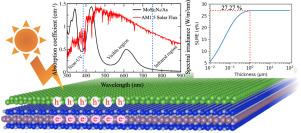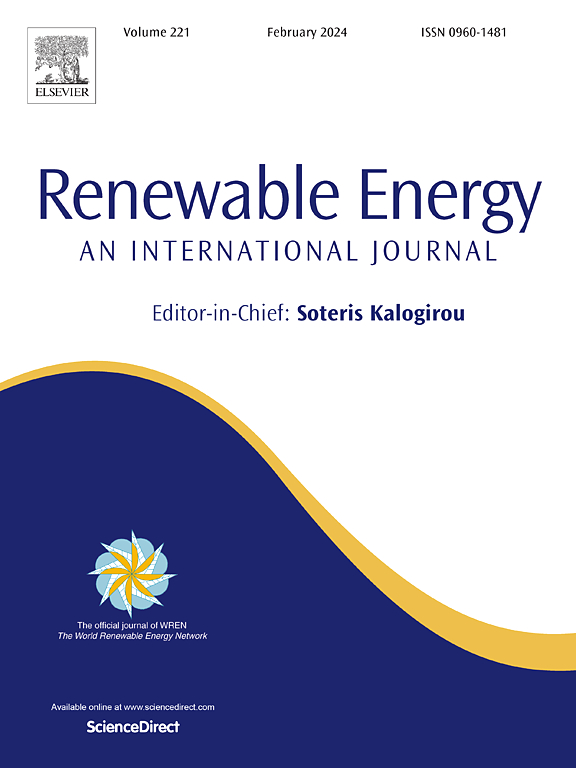Theoretical prediction of a high-performance two-dimensional type-II MoSi2N4/As vdW heterostructure for photovoltaic solar cells
IF 9
1区 工程技术
Q1 ENERGY & FUELS
引用次数: 0
Abstract
Solar cells are expected to become one of the dominant electricity generation technologies in the coming decades. Developing high-performance absorbers made from thin materials is a promising pathway to improve efficiency and reduce cost, accelerating the widespread adoption of these photovoltaic cells. In the present work, we have systematically investigated the 2D MoSi2N4/Arsenene van der Waals (vdW) heterostructure, which exhibits a type-II band alignment with an indirect band gap semiconductor (1.58 eV), that can effectively separate the photogenerated electron–hole (e–h) pairs. Compared to the isolated MoSi2N4 and Arsenene monolayers, the optical absorption strength can be significantly enhanced in MoSi2N4/Arsenene vdW heterostructure (in the order of 105 cm−1 in the visible region). The calculated optical absorption gaps are 2.12 eV (Arsenene) and 1.76 eV (MoSiN), with excitonic binding energies of 0.05 eV for arsenene and 0.48 eV for MoSiN, indicating that both materials can effectively form excitons and separate charges. Moreover, we found a high spectroscopic limited maximum efficiency of 27.27% for the MoSi2N4/Arsenene vdW heterostructure, which is relatively higher compared to previously reported 2D heterostructures. Ab-initio molecular dynamics (AIMD) simulations at 300 K, 600 K, and 900 K were conducted to evaluate the thermal stability of the MoSi2N4/Arsenene heterostructure. Simulations in the presence of water and NO at 300 K were also performed to assess its resilience to humidity and pollutants. The results suggest strong stability under harsh environmental conditions. Our findings demonstrate that the 2D MoSi2N4/Arsenene vdW heterostructure is an excellent candidate for both photovoltaic device applications and optoelectronic nanodevices.

用于光伏太阳能电池的高性能二维 II 型 MoSi2N4/As vdW 异质结构的理论预测
太阳能电池有望在未来几十年内成为最主要的发电技术之一。开发由薄材料制成的高性能吸收器是提高效率和降低成本的一条大有可为的途径,可加速这些光伏电池的广泛应用。在本研究中,我们系统地研究了二维 MoSi2N4/Arsenene 范德瓦耳斯(vdW)异质结构,该结构具有间接带隙半导体(1.58 eV)的 II 型带排列,能有效分离光生电子-空穴(e-h+)对。与孤立的 MoSi2N4 和砷单层相比,MoSi2N4/砷 vdW 异质结构的光吸收强度明显增强(在可见光区域大约为 105 cm-1)。计算得出的光吸收间隙分别为 2.12 eV(砷烯)和 1.76 eV(MoSi2N4),其中砷烯的激子结合能为 0.05 eV,MoSi2N4 为 0.48 eV,这表明这两种材料都能有效地形成激子并分离电荷。此外,我们还发现 MoSi2N4/Arsenene vdW 异质结构的光谱限制最大效率高达 27.27%,与之前报道的二维异质结构相比相对较高。为了评估 MoSi2N4/Arsenene 异质结构的热稳定性,研究人员分别在 300 K、600 K 和 900 K 下进行了原子内分子动力学(AIMD)模拟。此外,还在水和二氧化氮存在的 300 K 条件下进行了模拟,以评估其对湿度和污染物的适应性。结果表明,这种异质结构在恶劣的环境条件下具有很强的稳定性。我们的研究结果表明,二维 MoSi2N4/Arsenene vdW 异质结构是光伏器件应用和光电纳米器件的绝佳候选材料。
本文章由计算机程序翻译,如有差异,请以英文原文为准。
求助全文
约1分钟内获得全文
求助全文
来源期刊

Renewable Energy
工程技术-能源与燃料
CiteScore
18.40
自引率
9.20%
发文量
1955
审稿时长
6.6 months
期刊介绍:
Renewable Energy journal is dedicated to advancing knowledge and disseminating insights on various topics and technologies within renewable energy systems and components. Our mission is to support researchers, engineers, economists, manufacturers, NGOs, associations, and societies in staying updated on new developments in their respective fields and applying alternative energy solutions to current practices.
As an international, multidisciplinary journal in renewable energy engineering and research, we strive to be a premier peer-reviewed platform and a trusted source of original research and reviews in the field of renewable energy. Join us in our endeavor to drive innovation and progress in sustainable energy solutions.
 求助内容:
求助内容: 应助结果提醒方式:
应助结果提醒方式:


